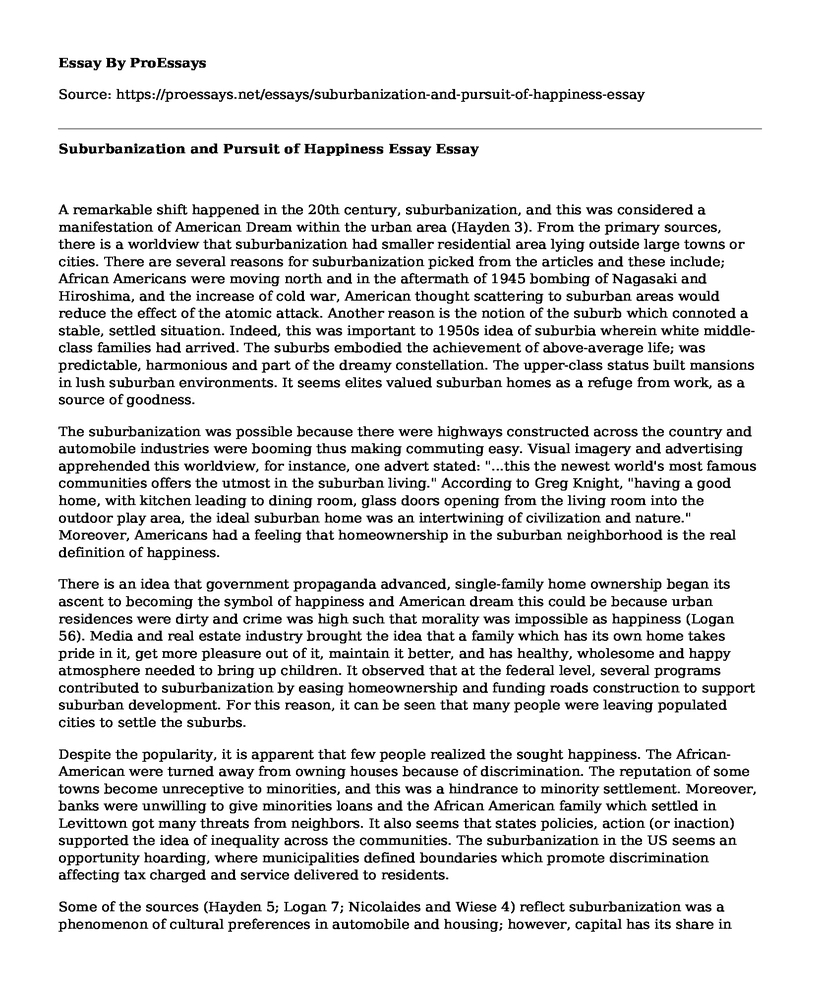A remarkable shift happened in the 20th century, suburbanization, and this was considered a manifestation of American Dream within the urban area (Hayden 3). From the primary sources, there is a worldview that suburbanization had smaller residential area lying outside large towns or cities. There are several reasons for suburbanization picked from the articles and these include; African Americans were moving north and in the aftermath of 1945 bombing of Nagasaki and Hiroshima, and the increase of cold war, American thought scattering to suburban areas would reduce the effect of the atomic attack. Another reason is the notion of the suburb which connoted a stable, settled situation. Indeed, this was important to 1950s idea of suburbia wherein white middle-class families had arrived. The suburbs embodied the achievement of above-average life; was predictable, harmonious and part of the dreamy constellation. The upper-class status built mansions in lush suburban environments. It seems elites valued suburban homes as a refuge from work, as a source of goodness.
The suburbanization was possible because there were highways constructed across the country and automobile industries were booming thus making commuting easy. Visual imagery and advertising apprehended this worldview, for instance, one advert stated: "...this the newest world's most famous communities offers the utmost in the suburban living." According to Greg Knight, "having a good home, with kitchen leading to dining room, glass doors opening from the living room into the outdoor play area, the ideal suburban home was an intertwining of civilization and nature." Moreover, Americans had a feeling that homeownership in the suburban neighborhood is the real definition of happiness.
There is an idea that government propaganda advanced, single-family home ownership began its ascent to becoming the symbol of happiness and American dream this could be because urban residences were dirty and crime was high such that morality was impossible as happiness (Logan 56). Media and real estate industry brought the idea that a family which has its own home takes pride in it, get more pleasure out of it, maintain it better, and has healthy, wholesome and happy atmosphere needed to bring up children. It observed that at the federal level, several programs contributed to suburbanization by easing homeownership and funding roads construction to support suburban development. For this reason, it can be seen that many people were leaving populated cities to settle the suburbs.
Despite the popularity, it is apparent that few people realized the sought happiness. The African-American were turned away from owning houses because of discrimination. The reputation of some towns become unreceptive to minorities, and this was a hindrance to minority settlement. Moreover, banks were unwilling to give minorities loans and the African American family which settled in Levittown got many threats from neighbors. It also seems that states policies, action (or inaction) supported the idea of inequality across the communities. The suburbanization in the US seems an opportunity hoarding, where municipalities defined boundaries which promote discrimination affecting tax charged and service delivered to residents.
Some of the sources (Hayden 5; Logan 7; Nicolaides and Wiese 4) reflect suburbanization was a phenomenon of cultural preferences in automobile and housing; however, capital has its share in making suburban and cities. Policies around transportation, service provisions, taxation, zoning and land use made suburbs to exclude minority and low-income peoples, broadening the gap and affecting the happiness sought, the American dream. It is evident that the package of happiness was selectively realized and those who got homes in suburban area faces challenges (Duany, Plater-Zyberk and Speck 12). Suburban father had long and time-consuming commutes to and from their workplaces, mothers become chauffeurs, taking kids to sports and doctors, and housemakers were forced to have clubs to meet while children were in school (Leinberger par.5). To date, suburbs are mostly unstable areas because of great metropolitan dynamic.
Works Cited
"1950S and 1960S Boom, Migration and Industrial Decline - Columbus Neighborhoods." Columbus Neighborhoods. N.p, 2014. Web. 27 June 2018.
BIBLIOGRAPHY Duany, A, E Plater-Zyberk and J Speck. Suburban Nation: The Rise of Sprawl and the Decline of the American Dream. New York: North Point Press, 2001.
Hayden, D. Building Suburbia: Green Fields and Urban Growth, 18202000. New York: Pantheon Books, 2003.
Leinberger, C. B. " The Next Slum?" 2008.
Logan, J. "Separate and unequal in suburbia." Census brief prepared for US2010. 2014.
Nicolaides, Becky and Andrew Wiese. "Suburbanization in the United States after 1945." Urban History (2017): 2-6.
Passarelli, James. "Cold War Suburbanization." Corporate Eden: <br />Business & the <br />Westchester Landscape. N.p., 2015. Web. 27 June 2018.
Teaching.msa.maryland.gov. N.p., 2018. Web. 27 June 2018.
Cite this page
Suburbanization and Pursuit of Happiness Essay. (2022, Jun 22). Retrieved from https://proessays.net/essays/suburbanization-and-pursuit-of-happiness-essay
If you are the original author of this essay and no longer wish to have it published on the ProEssays website, please click below to request its removal:
- Therapeutic Recreation in Nursing Homes - A Public Health Essay
- Ethics in Italy Migrant Deportation Essay
- Paper Example on Different Waves of Feminism in Canadian History
- Essay Sample on The Process of Voir Dire
- The Relation of the Elderly and Poverty to the Disciplines of Psychology - Paper Example
- Essay Example on Mental Health: Complex, Universal and Prevalent
- Role of Indigenous Canadian Women in the Fur Trade - Free Essay







